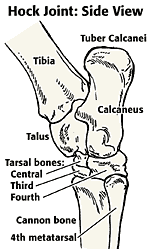A horse's hindlegs attach to the spine with bone, unlike the foreleg! The advantage being that the forces to propel the horse forward are directly transferred to the spine BUT there will be more concussive forces transferred too.
Is made up of the ilium, ishium and the pubis. These bones are all fused together to make one larger bone which articulates with the lumbar vertebrae, sacrum, coccygeal vertebrae and the head of the femur. The ilium is the largest bone, it is flattened at the top and this triangular shaped plate forms part of the roof and outer wall of the pelvic cavity. The large 'corner' of the bone forms the tuber coxae (or hip joint). Another corner forms the croup which is the highest point of the hindquarters. The ishium and pubis together form the floor of the pelvis. At the back the ishium is thicker to form the tuber ischii (seat bone).
The Hip Joint is formed between the head of the femur and the cup which is formed where the ilium, pubis and ischium meet - this is called the acetabulum.
This is a long bone and one of the heaviest and strongest in the body. It is shaped to provide attachments for many muscles which are important for the movement of the upper part of the hindleg. This includes the gluteals, biceps femoris and iliopsoas muscles. It also provides attachment for several ligaments.
The Femur's upper end is a hemispherical head which fits perfectly into the acetabulum. Also, at the upper end (but on the outer side) is the Major Trochanter, this is a prominence of bone which continues as a ridge (Trochanteric ridge) down to merge with the Third Trochanter (another prominence of bone). Both prominence's provide places for the gluteals to attach; the superficial gluteal muscle to the Third Trochanter and the deep and middle gluteals to the Major Trochanter. The iliopsoas muscle attahces to the Minor Trochanter which is a smaller prominence on inner side of the femur (opposite the Third Trochanter).
On the front side at the bottom, the femur has a groove known as the Trochlea. This groove is covered with fibrocartilage and provides a smooth surface for the patella to glide. On the back of the lower end of the femur there are condyles which form the upper part of the stifle joint. These articulate with the head of the tibia.
The Stifle joint corresponds to the human knee. It has 2 articulations, the first between the Tibia and Femur and the second between the Patella and the Femur. The Patella is a sesamoid bone and works to transmit pull from the muscles and through to the Tibia via the patellar ligaments.
The Tibia is another long bone. The upper end has the tibial tuberosity (another prominence of bone) which provides attachment for the patellar ligaments. The upper end also has the tibial spine - a short raised prominence - either side of this are condyles which again provide attachments for muscles. These muscles will become tendons which in turn act on the lower leg!
The lower end of the Tibia has 2 grooves which are separated by a ridge of bone. These fit perfectly with the Talus (a bone of the hock). The Fibula is shorter 'long' bone which joins to the Tibia at one of the upper condyles and then again meets the Tibia about a third of the way down. They are fused at the bottom to form the lateral malleolus.
This is the hock and as with the knee is made up of six bones and several joints! However the Talus is the only bone which articulates with the Tibia. Again the bones are short and flat and arranged in rows. The Calcaneous is the largest bone in the hock and the tuber calcis (point of the hock) is the large bony protruberance at the back.
From the hock down the hindleg is the same as the foreleg anatomically. The angles are different though!
It is so important that we look after the bones and joints to keep them happy and healthy and so keep our horses happy and healthy too!
Merry Christmas!
Did you see this week's video 'How to ... make some horsey Christmas Treats' on my You Tube channel.
Horse Life and Love. Please check it out and SUBSCRIBE.
You can also follow me on Facebook and Instagram for updates on Chesney, Basil, Tommy and Daisy.
Until next time!
Jo





No comments:
Post a Comment